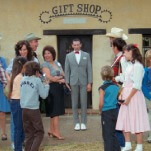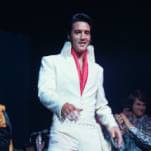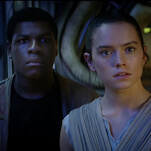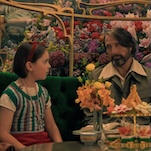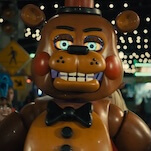Ben Munson
Elderly men have every right to be shirtless. But do they have the right to plaster derogatory Nazi slang for homosexuals across their naked chests while standing in a peaceful pasture and eerily staring off into space? On the cover of Digital Leather’s Warm Brother they apparently do, and it’s that swirling storm of offensive terminology, bushy mustache, man-nipples, creepy look, and odd setting that almost made me pass up listening to Shawn Doree’s latest album. Once past that cover—and Doree describing his music as “new wave Nazi fag punk”—I found it was much more in line with his other description (“electro-acoustic space folk”), and that Warm Brother is filled with distorted gems like “Gold Hearts” and “Not Now.” Now it’s hard to imagine that a man capable of songs like “Kisses” that manage to be sweet without being nauseating would also be capable of an album cover that nauseates in so many different ways.
Keith Phipps
I’m a big Steely Dan fan, but is there an uglier album cover than the band’s 1972 debut Can’t Buy A Thrill? A garish collage of what looks like a vintage photograph of streetwalkers, old pulp covers, neon tubing, and a pair of disembodied lips, it’s hideous on every possible level, sickeningly mixing colors never meant to appear next to one another, then topping it with a throwback font that suggests Steely Dan might be a ’50s cover band for unrepentant greasers. The Dan had a spotty record with cover art. Later efforts like Aja and Gaucho have an elegance that reflects the contents, but Donald Fagen and Walter Becker’s reissue liner notes for The Royal Scam call it “the most hideous album cover of the seventies, bar none” before qualifying the statement with “(excepting perhaps Can’t Buy A Thrill).” (Incidentally, cover seems to have at least one fan: Jeff Koons.)
Steven Hyden
When we did the Inventory on great ’00s albums with questionable covers, the record that immediately came to mind was The Hold Steady’s Boys And Girls In America. “Was there a greater disparity this decade between a pussy-ass album cover and its thoroughly kick-ass contents?” I wrote back then, and I still stand behind that sentiment. I’d love to ask Craig Finn why exactly he went with the pink lettering and the glossy photos of young and pretty audience members to represent some of the ballsiest songs he’s ever written. I still don’t get it. I always love playing this album, and hate looking at it.
Joel Keller
Back in the olden days of music, when “CDs” were displayed at “record stores” in “longboxes,” people at the big “mall chains” (for the kids out there, there once used to be a place called “Sam Goody”) were a little skittish about what those boxes displayed. The band had to kowtow to the wishes of those chains, else their album wouldn’t be available to the vast majority of the era’s available listeners. So when Jane’s Addiction’s classic 1990 album Ritual De Lo Habitual hit store shelves with a cover depicting two naked women and a naked man post-coitus—supposedly a reference to the epic song “Three Days”—the big chains shit their pants. And, because the band was at the point in its life where the big chains were eager to stock the much-anticipated album, Warner Bros. forced the band to issue a “clean” version of the cover. All it had was the band name and the album name in black print on a white background, with the First Amendment below it. The back had a screed about how we should protect our right to freedom of speech, lest “Hitler’s syphilis-ridden dreams” come true. Because that plain cover was in most of the big mall chains, I’m sure there are millions of people who now have the plain version of the cover in their dusty CD collections, because they either didn’t have access to the regular cover, or didn’t give a shit. Thank god for Pier Platters in Hoboken (or The Wiz… I can’t remember where I bought it) for having the CD with its proper cover. That’s what’s gathering dust in my CD collection.
Will Harris
It’s perhaps touch-and-go as to whether this applies, given that the cover was produced, but then either destroyed or covered with alternate artwork, but even as an obsessive Beatles fan, I still can’t look at the “butcher” cover of Yesterday & Today without shuddering. I can still remember flipping through Nicholas Schaffner’s The Beatles Forever—which, even now, remains my favorite book about the Fab Four, possibly because it has a happy ending (all four Beatles were still alive when it was published)—and being completely freaked out when I saw John, Paul, George, and Ringo wearing butchers’ smocks, brandishing raw meat and dismembered baby dolls. Photographer Robert Whitaker snapped the short for a conceptual art piece he was working on at the time, explaining in a 1991 interview, “I was trying to show that the Beatles were flesh and blood,” but even in 2011, the photo plays like a still frame from some serial killer’s home movies. Although The Beatles were apparently head over heels with the shot, with John calling it “as relevant as Vietnam,” and Paul describing it as “very tasty meat,” Capitol Records issued a formal apology for the disconcerting artwork and eliminated every copy of the album cover they could. (Schaffner cites the number of destroyed covers at 750,000.) Now, I’m all for artistic expression, and The Beatles will always be my favorite band, but I have to say that I’ve never once thought, “Oh, man, I can’t believe those bastards at Capitol did that!” That cover still creeps me out.
Marcus Gilmer
OutKast’s outstanding 1998 album Aquemini built on the Southern-fried hip-hop sound they built over the course of their first two albums (the banjo bounce of “Rosa Parks” and the sweaty, choir-backed grind of “Slump”), but like most of their albums, the cover art leaves much to be desired. I get what they were going for: an homage to blaxploitation films of the ’70s. But the artwork wound up somewhere between a bad Photoshop assignment and an airbrushed poster, a cheesy art project that betrays the fantastic album contained within. (Not for nothing, my favorite OutKast album cover is also the simplest: Stankonia’s cover features Big Boi and Andre 3000 posing in front of a black and white American flag.)
Sam Adams
One of the minor tragedies of the death of vinyl has been the steady diminishment of cover art. There isn’t much point in crafting an elaborate tableau like Sgt. Pepper’s’ pop-cultural kaffeeklatsch, to say nothing of Black Moses’ quintuple fold-out, when many people will experience it as an inch-square icon in the far corner of iTunes. Then again, sometimes the smaller, the better. Fever To Tell, the first full-length from the fitfully active NYC trio Yeah Yeah Yeahs, was a galvanizing shot of art-damaged garage rock, making instant stars of the band and securing the atypical ballad “Maps” a permanent place in the cultural unconscious. But Jesus Christ, did it have an ugly cover. Created by Cody Critcheloe, who mercifully devotes most of his time to singing in SSION, the crudely etched portrait of the band’s members standing beneath an el train, their heads shrouded in flame, is dominated by scabby reds and bilious yellows, and adorned for no apparent reason with clip art of snakes and what might be an elephant’s trunk. Nearly every inch is covered by some random scratch or squiggle; the eye has no place to rest, and eventually, it gives up. Not only is Fever To Tell’s cover unsightly, it’s almost impossible to look at. Don’t say I didn’t warn you:
































